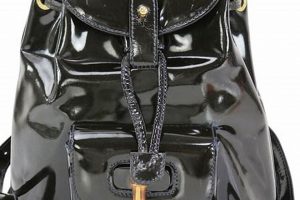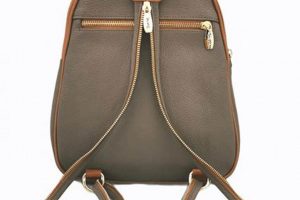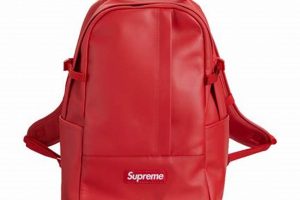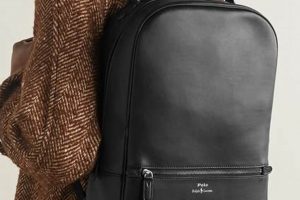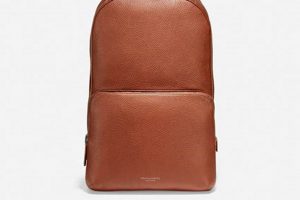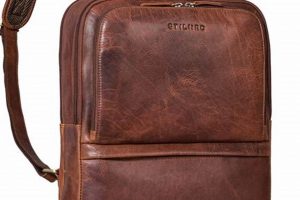A versatile accessory combines the features of a rucksack and a satchel, typically crafted from animal hide. This item offers the practicality of carrying belongings on one’s back, distributing weight evenly, while also providing the option to be worn over the shoulder or carried by hand via a handle, similar to a standard purse. An example would be an Italian leather product featuring detachable straps and multiple compartments, allowing for seamless transformation between carrying styles.
Such adaptable designs offer increased convenience and cater to diverse lifestyle needs. The ability to switch between carrying modes provides ergonomic advantages and stylistic flexibility. Historically, the evolution of carrying solutions has progressed from purely functional designs to incorporate aesthetic considerations and user-centric features, reflecting changing social norms and demands for adaptability in personal accessories.
The subsequent sections will delve into the specific design elements that contribute to the adaptability of these items, exploring materials, construction techniques, and the range of functionalities that define their appeal. Furthermore, considerations for selecting an appropriate model based on individual needs and style preferences will be addressed.
Selection and Maintenance Guidelines
This section presents essential guidelines for selecting and maintaining a versatile leather carrying solution. Adherence to these recommendations will ensure longevity and optimal performance.
Tip 1: Assess Material Quality: Examine the grain of the leather. Full-grain leather offers superior durability and develops a patina over time. Avoid products utilizing bonded or corrected-grain leather, which are more prone to wear and tear.
Tip 2: Evaluate Hardware Durability: Inspect the zippers, clasps, and buckles. Opt for solid metal hardware, preferably brass or stainless steel, as these materials resist corrosion and withstand repeated use. Ensure that all hardware is securely attached to the leather.
Tip 3: Consider Compartmentalization: Evaluate the internal layout. Multiple compartments and pockets aid in organization and prevent items from shifting during transport. Look for padded compartments to protect delicate electronics.
Tip 4: Analyze Strap Construction: Examine the straps and attachment points. Reinforced stitching and durable materials, such as nylon webbing, are crucial for supporting heavy loads. Ensure that straps are adjustable and comfortable.
Tip 5: Verify Conversion Mechanism: Test the conversion process. Ensure that the straps can be easily and securely reconfigured between backpack and shoulder bag modes. A smooth and intuitive conversion mechanism enhances usability.
Tip 6: Implement Regular Cleaning: Clean the leather periodically with a specialized leather cleaner and conditioner. This prevents the leather from drying out and cracking. Avoid using harsh chemicals or abrasive cleaners.
Tip 7: Protect from Moisture: Shield the leather from excessive moisture. When exposed to rain or snow, allow the product to air dry naturally away from direct heat. Consider applying a leather protectant spray to repel water.
Selecting a product with high-quality materials, durable hardware, and a functional design, combined with proper maintenance, will ensure years of reliable service and aesthetic appeal.
The concluding section will summarize the key advantages of these adaptable items and offer final considerations for potential purchasers.
1. Adaptable Carrying
Adaptable carrying is an essential characteristic defining the functionality of a leather item that transforms between a backpack and a handbag. Without the capacity for alteration in carrying style, the item remains simply either a backpack or a handbag, forfeiting the inherent advantage of the “convertible” designation. The ability to adapt directly addresses a consumer need for versatility; an item capable of morphing between forms facilitates use in varied settings, from professional environments where a handbag is preferred to more casual or travel situations where the hands-free convenience of a backpack is advantageous. A commuter, for example, might utilize the backpack configuration during a train ride and then convert the item to a handbag upon arrival at the office.
The mechanism facilitating adaptable carrying can manifest in several design approaches. Detachable straps are a common feature, allowing for removal and reconfiguration depending on the desired carrying method. Concealable straps, which can be tucked away when not in use, provide a streamlined appearance when the item is used as a handbag. Internal support structures and reinforced attachment points are also critical; these elements ensure structural integrity regardless of the chosen configuration, preventing undue stress on the leather and hardware. The presence of multiple handles, strategically positioned, allows for comfortable carrying in handbag mode.
The practical significance of adaptable carrying lies in its responsiveness to evolving lifestyle demands. By combining the ergonomic benefits of a backpack with the aesthetic appeal and professional appropriateness of a handbag, the convertible design transcends the limitations of single-purpose carrying solutions. Though requiring careful design and construction to maintain durability and ease of conversion, adaptable carrying elevates the standard leather accessory from a mere container to a multi-functional tool. Its success hinges on the seamless integration of form and function, providing the user with genuine flexibility without compromising quality or style.
2. Premium Material
The utilization of premium materials is intrinsically linked to the value proposition and longevity of a convertible leather backpack handbag. The choice of material dictates not only the aesthetic qualities of the item but also its durability, functionality, and overall suitability for its intended purpose. The selection of superior materials is therefore paramount.
- Durability and Longevity
Premium leather, such as full-grain or top-grain varieties, exhibits exceptional resistance to wear and tear. Unlike lower-grade alternatives, these leathers possess a tightly woven fiber structure that withstands abrasion, stretching, and repeated use. A convertible design, by its nature, experiences frequent manipulation and stress due to the changing of carrying configurations. Consequently, the use of durable leather is essential to prevent premature degradation and ensure the item’s extended lifespan. Examples include vegetable-tanned leather, known for its robust nature, and high-quality chrome-tanned leather, valued for its flexibility and resistance to water damage.
- Aesthetic Appeal and Tactile Quality
Premium leather possesses a distinct visual and tactile quality that elevates the perceived value of the convertible backpack handbag. The natural grain patterns, subtle variations in color, and smooth, supple texture contribute to a sophisticated and luxurious aesthetic. This aesthetic appeal is particularly important given that the item is intended for use in both casual and professional settings. The tactile quality of premium leather enhances the user experience, providing a pleasant feel to the touch and an overall sense of quality craftsmanship. For instance, the use of high-end Italian leather would immediately signal quality and refinement.
- Structural Integrity and Form Retention
The ability of a leather to retain its shape and provide adequate structural support is critical for a convertible backpack handbag. Premium leathers, due to their inherent strength and density, prevent sagging, stretching, and deformation over time. This is particularly important for maintaining the item’s aesthetic appeal and ensuring that it functions effectively in both backpack and handbag configurations. Inferior materials may lack the structural integrity necessary to support the weight of the contents or withstand the stresses of daily use. The use of properly tanned and conditioned leather helps to maintain the item’s form and prevent premature wear.
- Resistance to Environmental Factors
Premium leather undergoes specialized tanning and finishing processes that enhance its resistance to environmental factors such as moisture, sunlight, and temperature fluctuations. This is particularly important for a convertible item that may be exposed to a variety of conditions during daily use. Leather that is properly treated with water-resistant finishes or UV protectants will maintain its appearance and structural integrity for a longer period. This resistance minimizes the risk of damage from rain, snow, or prolonged sun exposure, extending the item’s lifespan and preserving its aesthetic qualities.
In conclusion, the strategic implementation of premium materials is not merely a superficial consideration but an integral aspect of the convertible leather backpack handbag’s design and functionality. Durability, aesthetic appeal, structural integrity, and environmental resistance are all directly influenced by the choice of leather, rendering the selection of premium materials essential for creating a high-quality and long-lasting product. The investment in superior materials translates directly to enhanced user satisfaction and a prolonged product lifecycle.
3. Design Versatility
Design versatility is not merely an aesthetic consideration; it constitutes a core functional requirement for a convertible leather backpack handbag. Without a meticulously planned design that accommodates multiple carrying configurations and usage scenarios, the item would fail to deliver on its central promise of adaptability. The design must proactively address the transition between backpack and handbag modes, ensuring ease of conversion, structural integrity in both forms, and aesthetic coherence across these transformations.
The influence of design versatility can be observed in specific features. For example, strap attachment points require careful engineering to withstand stress from varied angles, whether worn on the back or over the shoulder. Interior compartmentalization must be adaptable; pockets and dividers should accommodate both the vertical orientation of a backpack and the horizontal profile of a handbag. Hardware choices also reflect design versatility: buckles, zippers, and clasps must be durable and aesthetically suitable for both casual and professional contexts. A product with a poorly designed conversion mechanism may render the item cumbersome and impractical, thereby undermining its value proposition. Consider a leather item with removable backpack straps that can be neatly tucked away and a top handle designed for a comfortable grip when carried as a handbag; this exemplifies design versatility in practice. The use of a neutral color palette and minimalist hardware further contribute to its adaptability for various occasions.
Ultimately, the practical significance of design versatility lies in its ability to satisfy the demands of a dynamic lifestyle. By seamlessly integrating functionality and aesthetics, it transforms a simple carrying device into a versatile tool capable of navigating diverse environments and situations. However, realizing design versatility presents challenges. The need to balance structural strength with aesthetic appeal requires sophisticated engineering and careful material selection. Successful products demonstrate a harmonious fusion of form and function, offering consumers genuine adaptability without compromising either quality or style. Design versatility is not an option but a foundational element in achieving the core purpose of the product.
4. Secure Closure
Secure closure is an indispensable element of a convertible leather backpack handbag, functioning as a primary safeguard for the contents contained within. A compromised closure mechanism negates the value of the item, irrespective of the quality of the leather or the ingenuity of the convertible design. The absence of a reliable closure directly correlates to an increased risk of theft, accidental loss of belongings, and exposure of contents to environmental elements. For instance, a handbag utilized in a crowded urban environment requires robust zippers or clasps to deter unauthorized access. Similarly, a backpack employed during outdoor activities necessitates a secure fastening to prevent items from falling out during movement.
The practical application of secure closure manifests in various design choices. Heavy-duty zippers, equipped with locking mechanisms, provide a high level of security and resistance to forced entry. Flap closures, secured by magnetic snaps or buckles, offer a balance of security and ease of access. Drawstring closures, often combined with additional securing features, are suitable for items where quick access is prioritized. The effectiveness of each closure type depends on the specific context and intended use of the convertible leather backpack handbag. Furthermore, the placement of closure mechanisms is critical; strategically positioning zippers or clasps in concealed or reinforced areas enhances their protective capabilities. Consider a design incorporating a zippered main compartment with an additional magnetic snap closure on the flap; this dual-layer approach provides enhanced security and peace of mind.
In summary, secure closure is not merely a supplementary feature but an essential determinant of the overall utility and practicality of a convertible leather backpack handbag. Its importance stems from the fundamental need to protect personal belongings and maintain the integrity of the item’s contents. Challenges in implementation include balancing security with ease of use and ensuring that the closure mechanism complements the overall aesthetic design. The understanding of the relationship between secure closure and the functionality of a convertible leather backpack handbag is crucial for both designers and consumers, influencing design choices and purchase decisions alike.
5. Ergonomic Comfort
Ergonomic comfort is not a peripheral concern but a central design consideration in the context of a convertible leather backpack handbag. The inherent adaptability of this item, transitioning between backpack and handbag configurations, necessitates a design that prioritizes the user’s physical well-being. The prolonged use of poorly designed carrying devices, regardless of their aesthetic appeal or material quality, can result in musculoskeletal strain, discomfort, and even long-term health issues. The correlation between ergonomic design and user experience is therefore direct and significant. A convertible item that fails to distribute weight effectively in backpack mode or lacks comfortable handles in handbag mode ultimately diminishes its value proposition.
The practical application of ergonomic principles manifests in several design features. Padded shoulder straps, adjustable to accommodate varying body sizes, are crucial for distributing weight evenly across the back and shoulders when the item is used as a backpack. A contoured back panel, designed to conform to the natural curvature of the spine, minimizes pressure points and promotes proper posture. In handbag configuration, well-padded and appropriately sized handles prevent hand fatigue and discomfort. The overall weight of the item, even when empty, must be minimized through careful material selection and efficient design. Consider a leather item featuring wide, padded shoulder straps with breathable mesh lining, coupled with a lightweight yet durable frame; this design prioritizes ergonomic comfort without sacrificing aesthetic appeal. Furthermore, the strategic placement of internal compartments aids in weight distribution, preventing uneven loading that can contribute to discomfort.
In summary, ergonomic comfort is not merely a desirable attribute but a fundamental requirement for a convertible leather backpack handbag to fulfill its intended purpose effectively. The challenges in implementation lie in balancing ergonomic design with aesthetic considerations and maintaining structural integrity throughout the conversion process. By prioritizing ergonomic comfort, manufacturers can create items that not only look stylish but also promote the user’s physical well-being, enhancing overall satisfaction and extending the product’s usable lifespan.
Frequently Asked Questions
The following section addresses common inquiries regarding convertible leather backpack handbags, providing detailed answers to facilitate informed purchasing decisions.
Question 1: What is the average lifespan of a convertible leather backpack handbag?
The longevity of this item depends primarily on the quality of the leather, hardware, and construction. Premium full-grain leather products, meticulously maintained, can last for several years. However, lower-quality materials and inadequate care can significantly reduce the lifespan. Regular conditioning and proper storage are crucial for preserving the leather’s integrity.
Question 2: How does the conversion mechanism typically function?
Conversion mechanisms vary among models. Common methods include detachable straps, which can be reconfigured for backpack or handbag use, and concealable straps that can be tucked away when not in use. The mechanism’s durability and ease of use are critical factors to consider.
Question 3: What is the weight capacity of these items?
Weight capacity varies depending on the size and construction of the item. It is imperative to consult the manufacturer’s specifications to avoid exceeding the recommended weight limit, which can compromise the structural integrity and lead to premature wear. Overloading the item can also compromise ergonomic comfort.
Question 4: How should a convertible leather backpack handbag be cleaned and maintained?
Cleaning and maintenance require specialized leather care products. Harsh chemicals and abrasive cleaners should be avoided. Regular conditioning helps prevent the leather from drying out and cracking. Promptly addressing spills and stains is essential to prevent permanent damage. Professional leather cleaning services may be necessary for more extensive cleaning.
Question 5: Are these items suitable for professional settings?
Suitability for professional settings depends on the design and style of the item. Minimalist designs in neutral colors are generally more appropriate for formal environments. Bold colors and overly casual designs may be less suitable for professional use.
Question 6: What are the common signs of wear and tear?
Common signs of wear and tear include scratches, scuffs, fading, and cracking of the leather. Hardware may also exhibit corrosion or breakage. Addressing these issues promptly through appropriate repairs or maintenance can extend the item’s lifespan.
In summary, convertible leather backpack handbags offer versatility and style. However, careful consideration of material quality, construction, and maintenance is essential for ensuring long-term satisfaction.
The subsequent section will provide guidance on selecting the optimal convertible leather backpack handbag for individual needs and preferences.
Conclusion
This exploration has illuminated the multifaceted characteristics of the convertible leather backpack handbag. The adaptable carrying mechanisms, the imperative of premium material selection, the importance of design versatility, the necessity of secure closures, and the significance of ergonomic comfort have been examined. These core elements collectively define the utility and value of this versatile accessory. Thorough evaluation of these aspects is crucial for both manufacturers seeking to create superior products and consumers seeking to make informed purchasing decisions.
The convertible leather backpack handbag represents a synthesis of functionality and style, catering to the demands of modern lifestyles. Its enduring appeal hinges on the continuous refinement of its design and the unwavering commitment to quality craftsmanship. Future advancements may incorporate smart technologies or innovative materials to further enhance its versatility and durability. The enduring importance of this accessory lies in its ability to seamlessly adapt to the evolving needs of its users, providing both practicality and aesthetic satisfaction.


